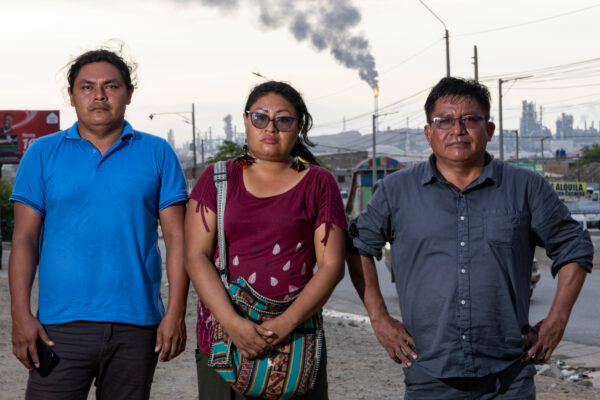The $1.7 billion Camisea gas project, one of Latin America’s key sources of energy, has come under the scrutiny of the U.S. Senate Foreign Relations Committee in its campaign against mismanagement and corruption in infrastructure ventures financed by the multinational development banks.
As committee chairman Richard Lugar said in his introduction to the inquiry, “The Camisea pipeline project in Peru brings natural gas and gas liquids to the Pacific Coast from fields owned by indigenous people in the interior. Financed with the help of the Inter-American Development Bank, the project began operating in 2004.
“Five spills have occurred in the natural gas liquids pipeline, and some non-governmental organisations (NGOs) have complained that local people have not seen the benefits the benefits from the gas royalties, a portion of which is earmarked for Peru’s military.”
The committee heard evidence from two first-hand witnesses, both former Ministers of Energy and Mines in Peru, and closely acquainted with development of the Camisea project which draws natural gas from the Cuzco region high up in the Andes. But the two men spoke from quite different viewpoints.
Jaime Quijandria, who quit his Ministerial appointments in November 2004 when he was invited to join the World Bank as executive director representing Peru and five other Latin American countries, opened his evidence by saying that his opinions would compromise neither the Inter-American Development Bank nor the Government of Peru.
The project has, he said, saved the country from a situation where Peru was becoming dangerously dependent on an annual one billion dollars worth of petroleum imports.
But since the Camisea project has come on stream, he claimed an annual increase of one per cent in Peru’s gross national product throughout this 30-year operation; government revenues are running at some $1.4 billion or nearly 20 per cent of its income; there has been an average 30 per cent reduction in electricity rates.
By law, he said, 50 per cent of the royalties have been transferred to the producing region (Cuzco), funding improvements in remote areas of the country.
“There is no existing legislation in any other South American country”, he said, “that mandates the transfer of such level of resources to the regional and municipal authorities.”
This information should have been highly satisfactory to the Senate Foreign Relations Committee, whose members have a strong interest both in national security and promoting economic progress around the world.
But Carlos Herrera Descalzi, presently Vice-Dean of Peru’s National Association of Engineers and himself a former Minister in the Peruvian Government, gave a somewhat different view of the situation.
The project has three components: the gas field and the fractional plant and export terminal near the Pacific port of Pisco ($730 million upstream); two pipelines in parallel trenches, one for natural gas and the other for liquids ($850 million downstream); the natural gas distribution network in Lima and Callao ($71 million).
The Inter-American Development Bank became involved when together with Latin American banks and Peruvian investors it put up $75 million as part of the initial $400 million funding.
IDB explains that it participated in Camisea to ensure adherence to the principles of sustainable development, which includes strong environmental and social safeguards and specific actions intended to create benefits for local populations.
This may have been the ideal, but Senor Descalzi’s evidence suggests that things did not proceed quite in conformity with these noble principles.
For example, according to this source, the principal factor in successful bidding for the development rights was the size of the royalty to be paid.
The gasfield contract was awarded to a consortium of small and medium-sized companies who offered a royalty of 37.24 per cent rather than to a larger company which in the view of the witness was much better qualified and offering 35.5 per cent.
Interpreting the English version of his evidence from the original Spanish, Carlos Descalzi said that the fact that most of the gas in the winning bid was assigned for export at lower royalties left people suspecting that this was an underhand manoeuvre to grant the contract to one particular party.
He alleged that in dedicating their efforts to raising finance through the private sector, Ministers overlooked their duties to local consumers. Not only that, in order to make construction of the gas pipelines viable at a time when there was insufficient demand to produce a return on the investment, electricity consumers were forced to pay a contribution in their tariff to subsidise the under-utilised gas transport capacity.
“In November 2002”, he said, “the government authorised a payment in advance; this resulted in a public contribution of nearly $100 million towards the cost of pipeline construction.”
Most of these allegations relate to the part of the project for which Transportadora de Gas del Peru (TGP) are responsible. This company is now faced with an independent inquiry into the causes of five spills from the gas condensate pipeline which are said to have given rise to serious pollution of water courses.
The Inter-American Development Bank says it is deeply concerned about the five spills that occurred on the gas liquids pipeline since 2004, including the most recent release in March 2006 in the Echarati district of Cuzco.
“The IDB fully supports the need for an immediate implementation of a pipeline integrity audit as specified by the agreement between TGP and Peruvian authorities. An internationally recognised engineering firm should perform this audit whose results should be disclosed to the public.”
That statement was put out soon after the Echarati release. There has been no further announcement from the bank as to who has been appointed to undertake this sensitive operation.













